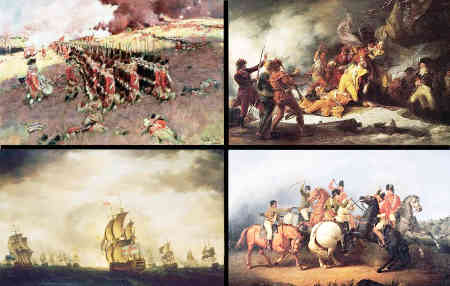War of Independence
Who did the Americans fight for their Independence?
American colonies had been under British administration for a long time. At the start, Britain helped America fight off the Spanish, the French and the native Indians. Then Britain placed its own troops in America to defend the colonies.
At the same time, Britain started imposing taxes on the colonies. The Americans didn’t like it and believed that only their own assemblies had the right to tax them, and not the British Parliament in London. Gradually, relationship between Americans and the British administration worsened.
Americans successfully resisted attempts by the British government to impose new taxes on them. Ultimately, matters got so bad that both sides engaged in armed conflict. This conflict finally began the American war of independence and ended British control in America.

What caused the Americans and the British to fight?
Britain had a large number of soldiers in America and the British government wanted to pay these soldiers by imposing taxes on Americans. Americans, on the other hand, believed that they could defend themselves well and need no British army, so they shouldn’t have to pay for it.
In 1765, British imposed Stamp Act, a new tax, but the Americans resisted it and forced the British Parliament to cancel the Act. In 1770, the incident of Boston Massacre occurred where British soldiers fired on Americans and killed six of them.
In 1773, British imposed another new tax on tea and the Americans responded by destroying the tea sent from London. So at one side, Britain kept trying to impose taxes and at the other hand, Americans kept trying to resist them. Initially, both sides fought politically. But in 1775, this turned into fighting with real guns, swords and soldiers.
How did the war start?
In April 1775, a column of the British army reached a town near Boston called Concord. They wanted to confiscate a cache of weapons. On their way back, the British army was attacked by the American militia and the British column faced significant losses before another British army came to its help.
This was the first spark. News spread and both the Americans and the British braced for full-scale war in most colonies. In Boston, a major British army arrived in May. By this time, American militia had also grown very large and had surrounded Boston, besieging the British army.

What was the first major battle of the war?
The first major battle was the Battle of Bunker Hill which took place in 1775. The Bunker Hill was located near Boston and was of important strategic value. American militia had already taken control of the hill before the British forces could take it.
But when British reinforcements arrived in May 1775, the British army decided to attack the hill. Although the British army was successful in taking control of Bunker Hill in June 1775, it suffered severe losses and nearly half of the British army was destroyed.
Because of this disastrous victory, the British forces were forced to cease any other actions against the Americans until reinforcements arrived from Britain.
- Birth of the USA
- 1st Amendment
- 2nd Amendment
- American Enlightenment
- American National Anthem
- Articles of Confederation 1777
- Betsy Ross
- Bill of Rights
- Birth of USA Timeline
- Christopher Columbus
- Declaration of Independence
- Federalism
- Is the United States a Democracy?
- Isolationism vs. Interventionism
- Liberty Bell
- Pledge of Allegiance
- The Torch of Liberty
- The U.S. Constitution
- Treaty of Paris
- War of Independence
- Washington D.C
- What Is The American Dream?